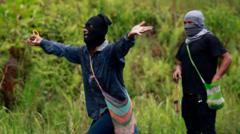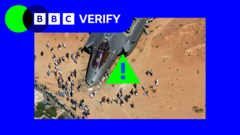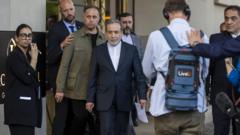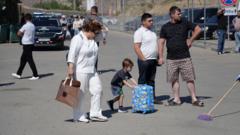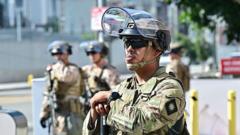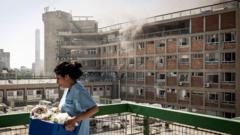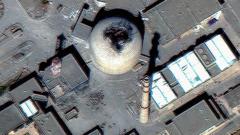The ongoing conflict has polarized young Iranian dissidents, with some supporting Israeli actions against their regime while others fear the resulting chaos could bring more suffering to civilians.**
Divided Perspectives: Young Iranians Weigh Options Amidst Israel-Iran Conflict**

Divided Perspectives: Young Iranians Weigh Options Amidst Israel-Iran Conflict**
As conflict escalates between Israel and Iran, young anti-regime Iranians express divergent views on foreign intervention.**
In the backdrop of escalating tensions between Israel and Iran, young Iranians opposing the regime find themselves grappling with complex feelings toward foreign military actions. Following Israel’s recent airstrikes targeting Iran, the bleak realities faced by many within the country have come into sharper focus. The Iranian leadership, known for its repressive tactics, has historically quelled dissent, leaving opposition groups largely operating from outside the country.
In a striking video message, Israeli Prime Minister Benjamin Netanyahu urged the Iranian populace to seize their freedom. However, reactions among young Iranians are divided. While some oppose the harsh regime and voices support for Netanyahu's statement, others are skeptical about the true intentions behind such calls for liberation.
Due to stringent internet restrictions imposed by the Iranian authorities, communications remain tenuous, but conversations with several youth reveal a range of sentiments about the conflict. On one end of the spectrum is Tara, 26, who expressed frustrations over the government’s deliberate restrictions to maintain control during conflicts. She argues that real enemies lie within, labeling the Islamic Republic as Iran's greatest threat rather than foreign forces.
Conversely, Sima, 27, is more resigned. Despite harboring no love for Israel, she wishes for a swift resolution to the regime's oppression, reflecting a sentiment among some youth who see foreign intervention as a possible savior from the longstanding tyranny. Amir, 23, embodies a robust endorsement for strikes against the regime, criticizing the inaction of the international community and advocating for foreign assistance in dismantling a regime he feels has inflicted prolonged hardship.
Yet, amid the chorus of voices, caution emerges. Activists like Navid, 25, fear the potential collateral damage of foreign military operations. He emphasizes that the hope for regime change shouldn't entail total destruction, fearing that some may eventually sympathize with hardline leaders in response to foreign violence.
The criticism of Israeli actions resonates with others, as Darya, 26, notes a discernible public hesitance to protest amid bombings, pointing to an acknowledgment of civilian suffering. Younger voices like Arezou, 22, echo the internal conflict felt by many: loathing the regime while grappling with the moral implications of support for Israeli military actions.
In an environment steeped in uncertainty and peril, Mina, 27, articulates a yearning for genuine change devoid of violence, arguing against the notion that military strikes will pave the way for freedom. Many express a desire for a resolution that prioritizes the safety and dignity of civilians over a choice of perceived evils, raising a crucial question: how does one advocate for freedom without perpetuating a cycle of terror?
As tensions simmer, the Iranian youth's narrative reveals a complex landscape of hope, fear, and introspection, intersecting personal desires for freedom with the harsh realities of geopolitical conflict. The consequences of these conflicts will likely shape the future of Iran and the lives of those seeking change within its borders.
In a striking video message, Israeli Prime Minister Benjamin Netanyahu urged the Iranian populace to seize their freedom. However, reactions among young Iranians are divided. While some oppose the harsh regime and voices support for Netanyahu's statement, others are skeptical about the true intentions behind such calls for liberation.
Due to stringent internet restrictions imposed by the Iranian authorities, communications remain tenuous, but conversations with several youth reveal a range of sentiments about the conflict. On one end of the spectrum is Tara, 26, who expressed frustrations over the government’s deliberate restrictions to maintain control during conflicts. She argues that real enemies lie within, labeling the Islamic Republic as Iran's greatest threat rather than foreign forces.
Conversely, Sima, 27, is more resigned. Despite harboring no love for Israel, she wishes for a swift resolution to the regime's oppression, reflecting a sentiment among some youth who see foreign intervention as a possible savior from the longstanding tyranny. Amir, 23, embodies a robust endorsement for strikes against the regime, criticizing the inaction of the international community and advocating for foreign assistance in dismantling a regime he feels has inflicted prolonged hardship.
Yet, amid the chorus of voices, caution emerges. Activists like Navid, 25, fear the potential collateral damage of foreign military operations. He emphasizes that the hope for regime change shouldn't entail total destruction, fearing that some may eventually sympathize with hardline leaders in response to foreign violence.
The criticism of Israeli actions resonates with others, as Darya, 26, notes a discernible public hesitance to protest amid bombings, pointing to an acknowledgment of civilian suffering. Younger voices like Arezou, 22, echo the internal conflict felt by many: loathing the regime while grappling with the moral implications of support for Israeli military actions.
In an environment steeped in uncertainty and peril, Mina, 27, articulates a yearning for genuine change devoid of violence, arguing against the notion that military strikes will pave the way for freedom. Many express a desire for a resolution that prioritizes the safety and dignity of civilians over a choice of perceived evils, raising a crucial question: how does one advocate for freedom without perpetuating a cycle of terror?
As tensions simmer, the Iranian youth's narrative reveals a complex landscape of hope, fear, and introspection, intersecting personal desires for freedom with the harsh realities of geopolitical conflict. The consequences of these conflicts will likely shape the future of Iran and the lives of those seeking change within its borders.

